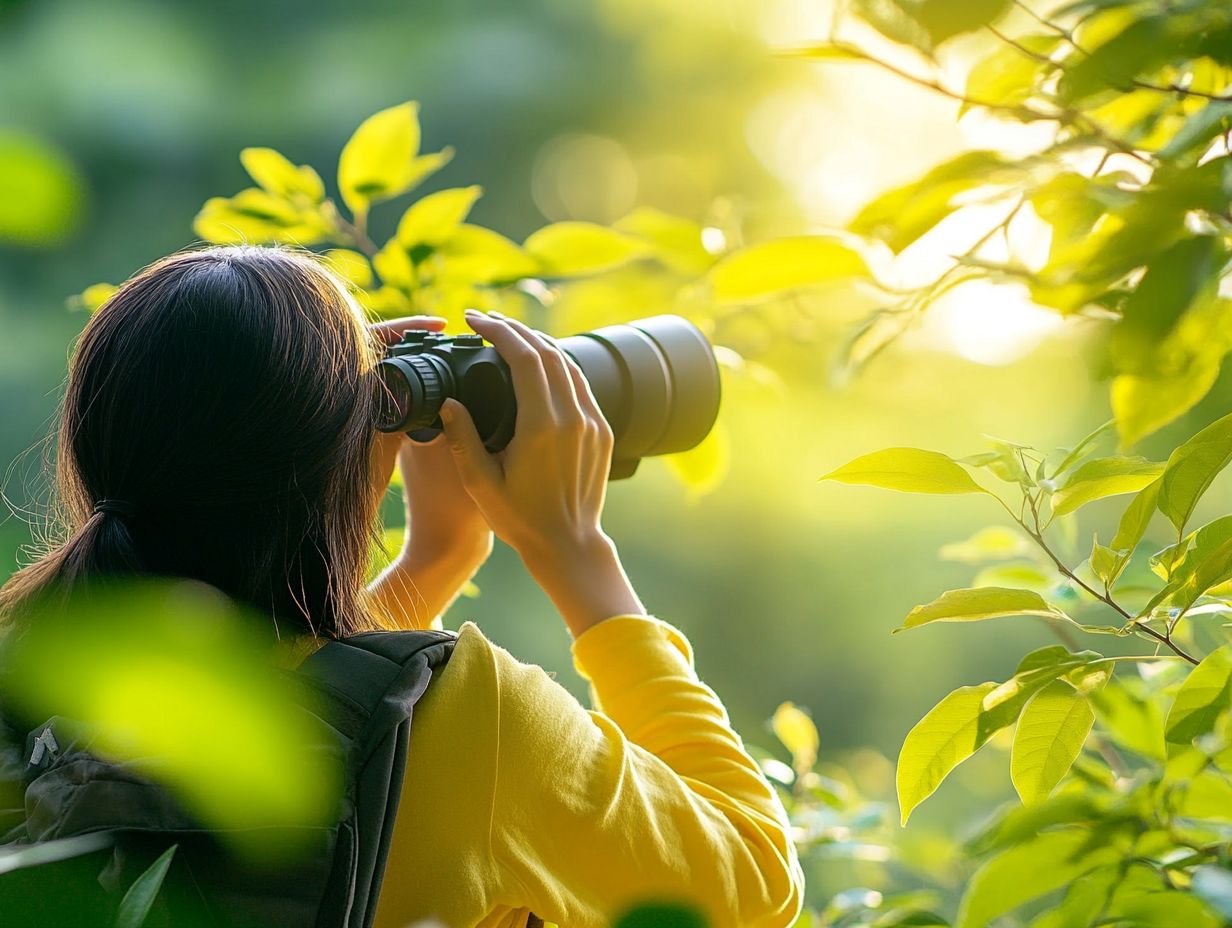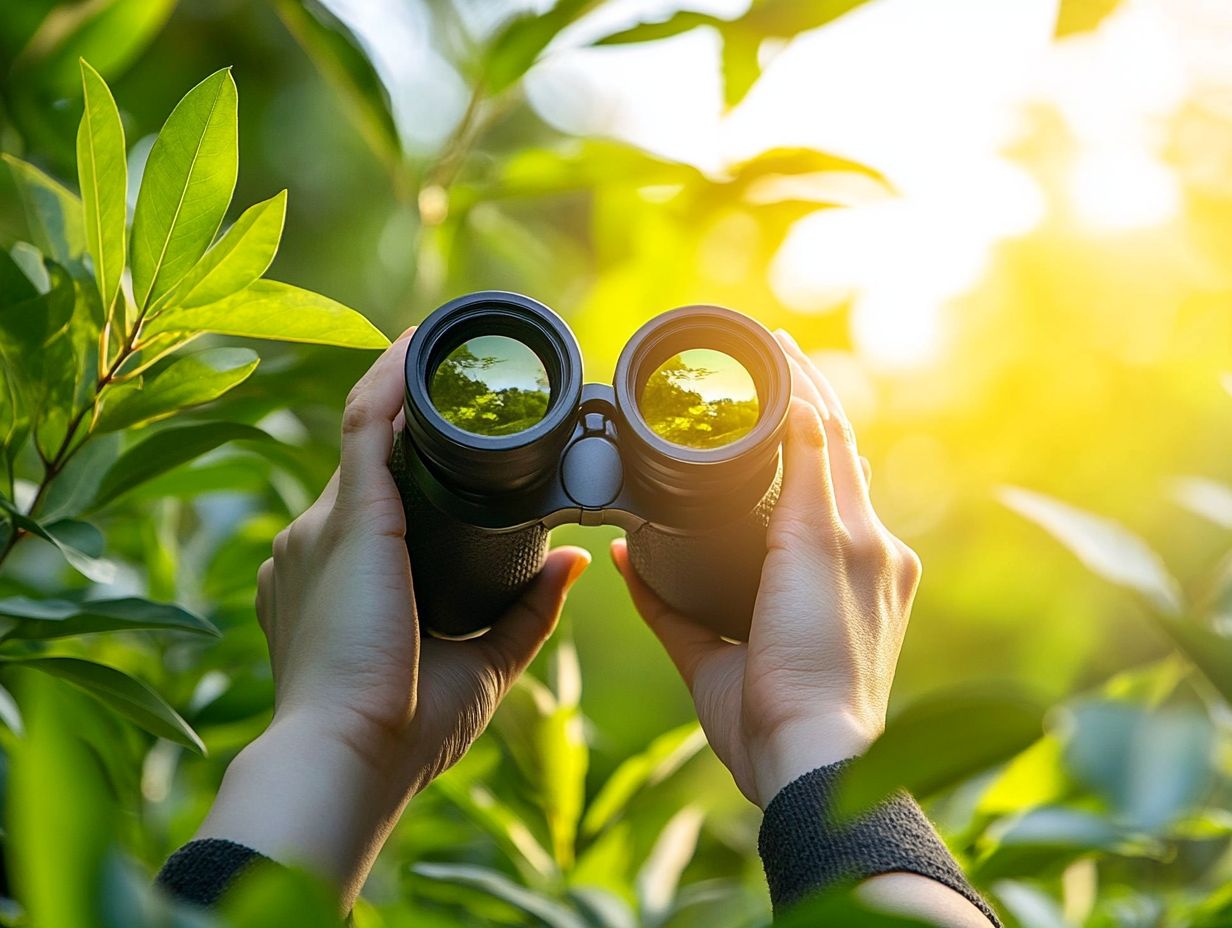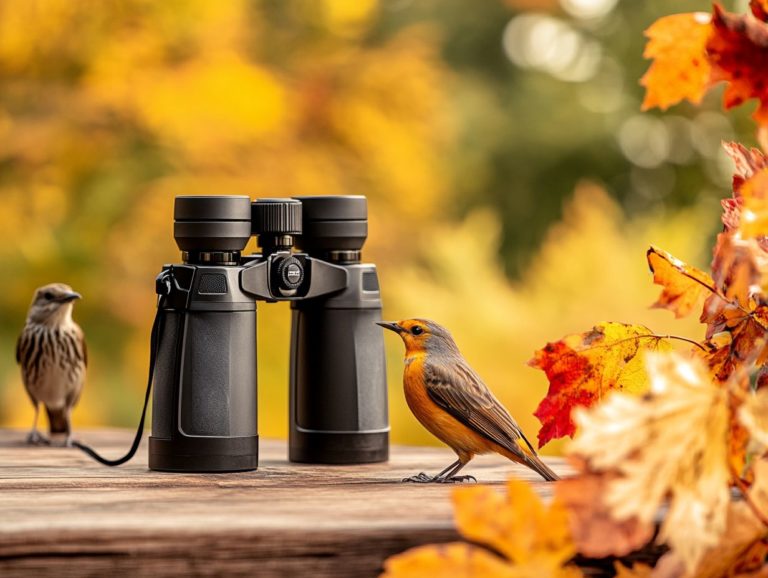How to Use Filters with Your Bird Watching Binoculars
Bird watching is a delightful hobby that immerses you in the beauty of nature. The right tools can truly elevate your experience.
Among these essential tools, binoculars are indispensable. They enable you to observe our feathered friends in breathtaking detail.
By incorporating filters with your binoculars, you can enhance your viewing experience even further.
Let’s dive into why binoculars are a must-have for bird watching!
Contents
- Key Takeaways:
- Bird Watching Binoculars: An Essential Tool
- Types of Filters for Bird Watching Binoculars
- How Filters Enhance Bird Watching Experience
- Tips for Using Filters with Your Bird Watching Binoculars
- Frequently Asked Questions
- 1. How do I attach filters to my bird watching binoculars?
- 2. What types of filters should I use with my binoculars for bird watching?
- 3. How do polarizing filters help with bird watching?
- 4. Can filters affect the image quality of my binoculars?
- 5. Are there any filters specifically designed for bird watching?
- 6. Do I need to use filters with my binoculars for bird watching?
Key Takeaways:

- Investing in a quality pair of binoculars is key to enjoying bird watching.
- Using filters can greatly enhance your bird watching experience by improving image clarity, reducing glare, and enhancing colors.
- Properly installing and adjusting filters, as well as choosing the right one, are important tips when using filters with your binoculars.
Bird Watching Binoculars: An Essential Tool
Bird watching binoculars are essential for birders. They provide the clarity and magnification needed to observe wildlife up close.
Modern models from High Point Scientific and Canon IS offer advanced features that enhance your experience.
These binoculars enable you to effortlessly identify various species. You can appreciate their unique calls and markings as you immerse yourself in nature’s beauty.
Choosing the right binoculars can profoundly influence your birding style, enhancing the overall experience and making it truly rewarding.
Why Binoculars are Important for Bird Watching
Binoculars are essential for your bird-watching adventures. They allow you to observe wildlife from a comfortable distance.
This minimizes disturbance to the birds’ natural habitats and elevates your overall experience.
These incredible instruments enhance your ability to identify various bird species. They provide a clearer view of subtle markings and behaviors that often escape the naked eye.
With the right pair of binoculars, you can appreciate the intricate details of plumage and the distinctive characteristics that set different species apart.
Embracing responsible birding practices is crucial for preserving bird welfare. This encourages you to maintain a respectful distance and ensures you don’t disrupt their habitats.
This delicate balance enriches your birding experience while fostering a deeper connection with wildlife, ultimately promoting conservation efforts for the future.
Types of Filters for Bird Watching Binoculars
Incorporating various types of filters can dramatically elevate your bird watching experience. They enhance visibility and minimize glare.
For instance, polarizing filters work wonders by diminishing reflections from surfaces like water. This allows you to spot elusive waterfowl with ease.
Moreover, solar filters typically used for observing sunspots during a total solar eclipse can be ingeniously adapted from classic angler techniques or crafted using 3D printed filter holders.
These enhancements will take your outdoor adventures to new heights of enjoyment.
Color Filters and Objective Filters
Color filters can significantly enhance your bird watching experience by fine-tuning hues and contrasts. This allows you to easily distinguish between various bird species and their unique calls.
These filters selectively block certain wavelengths of light, revealing subtle differences in plumage colors that might otherwise escape your notice.
For example, employing a blue filter can amplify the vibrant hues of a bird’s feathers, making its patterns stand out in a visually striking manner.
This technique transcends bird watching; you can also apply it when observing sunlight filtering through leaves or documenting other wildlife. It enriches the overall visibility and charm of the experience.
By utilizing color filters, you not only elevate your observations but also cultivate a deeper appreciation for nature’s intricate details.
Polarizing Filters

Polarizing filters are essential for bird watchers. They dramatically reduce glare from sunlight and allow for clearer visibility of birds in their natural habitats.
These filters minimize reflections on water surfaces and other shiny materials. This advantage is especially pronounced when observing birds near lakes, rivers, or ponds, where light can bounce off the water and obscure crucial details.
Using a polarizing filter enhances color saturation, making the natural hues of feathers pop beautifully. For the best results, position yourself at a 90-degree angle to the sun when using these filters; this ensures optimal polarization.
Regularly adjusting the filter can also unveil hidden wildlife, making each outing not just enjoyable but truly rewarding.
Neutral Density Filters
You ll find neutral density filters invaluable as a bird watcher. They allow you to control light intensity while observing your feathered friends, ensuring optimal visibility even under the brightest sunlight.
These filters uniformly reduce the amount of light entering your lens without distorting colors or contrast. This feature is especially advantageous during harsh midday hours when sunlight can overwhelm your images, leading to overexposure and a loss of detail in both the birds’ plumage and the surrounding environment.
By incorporating these filters into your setup, you can achieve clear images and vibrant colors, capturing the exquisite beauty of avian subjects with remarkable precision. Furthermore, using neutral density filters grants you greater flexibility in adjusting the speed of the camera’s shutter, enabling you to capture sharper shots of birds in motion while maintaining a lovely depth of field.
How Filters Enhance Bird Watching Experience
Filters elevate your bird-watching experience by enhancing image clarity and contrast, minimizing glare, and enriching colors and details. Imagine spotting a rare bird with perfect clarity!
Improving Image Clarity and Contrast
Improving image clarity and contrast is essential for your birdwatching experience. It enables you to discern subtle features critical for accurate bird identification.
In various birding scenarios, using the right filters can elevate your viewing experience to new heights. Imagine observing a vibrant Scarlet Tanager nestled among the leafy canopy; employing a polarizing filter will dramatically reduce glare and reflections, allowing the bird s stunning colors and intricate feather patterns to shine through.
When you re tracking elusive shorebirds along a winding coastal trail, a neutral density filter enhances contrast against the often bright sky and shimmering water. This makes it easier for you to identify key features such as beak shape and wing markings. These enhancements prove invaluable for bird watchers eager to spot rare species or witness behaviors that might otherwise slip by unnoticed.
Reducing Glare and Reflection
Reducing glare and reflection stands out as one of the primary advantages of using filters while bird watching. They allow you to see birds with remarkable clarity, free from distractions.
The science behind this phenomenon revolves around the interaction of light with surfaces, which can create unwanted brightness that obscures fine details. When you apply filters, you effectively diminish these disturbances by blocking specific wavelengths of light that contribute to glare, enhancing your visual clarity during wildlife observation.
By leveraging polarized filters, you can significantly elevate your visual experience. This enables you to discern intricate feather patterns and behaviors that might otherwise escape your notice. This clarity is essential for both avid birders and researchers alike, who depend on accurate observations for thorough documentation and study.
Enhancing Colors and Details

Enhancing colors and details transforms your bird-watching experience into something truly vibrant and enjoyable. It allows you to fully appreciate the stunning beauty and intricate behaviors of birds.
Imagine the vibrant colors you can see by using special filters that help reduce glare and improve color, like polarizing filters or UV filters. These can elevate your observations, capturing the vivid hues of plumage that might otherwise remain subdued. For instance, a polarizing filter reduces glare from water surfaces where certain species feed, making the striking reds and blues of a kingfisher’s feathers stand out brilliantly. These filters also enhance the contrast in detailed plumage patterns, which is essential for accurately identifying different species.
As you watch birds flit from branch to branch, the harmonious blend of their colors, accompanied by the enchanting background sounds of their calls, immerses you in a sensory experience. This deepens your appreciation for nature s artistry.
Tips for Using Filters with Your Bird Watching Binoculars
Using filters with your birdwatching binoculars can greatly enhance your experience when done correctly. Therefore, understanding the role of filters in bird photography is essential for achieving optimal performance.
Proper Installation and Adjustment
Properly installing and adjusting filters is crucial for achieving optimal viewing results with your binoculars.
Getting those filters set up correctly can significantly enhance the clarity and brightness of the images you see. Start by ensuring your binoculars are spotless; any dust or smudges can interfere with your viewing experience.
Next, carefully screw the filter onto the front of each lens. Make sure it s securely in place but not overly tight after all, you don t want to risk any damage.
Keep in mind that using the wrong type of filter for specific lighting conditions can lead to unsatisfactory results. For example, while UV filters can reduce glare, they might also dull colors. Testing different options in various environments will help you find the perfect balance for your nature observations.
Choosing the Right Filter for Your Needs
Selecting the right filter for your bird watching needs can enhance your observation experience and improve your ability to identify specific species.
When choosing a filter, consider the lighting conditions, which can change dramatically depending on the time of day and weather. For example, on bright, sunny days, polarized filters can significantly reduce glare, while overcast days may benefit from filters that boost color contrast.
Your birding activities will also influence your filter choice. Whether you re engaging in long-range observation or capturing quick snapshots requires a tailored approach. Personal preferences matter too; some bird watchers prioritize vibrant color capture, while others aim for sharp, clear images.
By thoughtfully considering these aspects, you can create a birding experience that s not only fulfilling but also genuinely enjoyable.
Frequently Asked Questions
1. How do I attach filters to my bird watching binoculars?

To attach filters to your binoculars, first, get the right size filter. Then, screw it onto the binoculars thread and ensure it is securely attached before use.
2. What types of filters should I use with my binoculars for bird watching?
Several types of filters can enhance your bird watching, including polarizing filters, neutral density filters, and color filters. Each type serves a different purpose, so understanding which one best suits your needs before purchasing is important.
3. How do polarizing filters help with bird watching?
Polarizing filters reduce glare from shiny surfaces. This helps you spot birds more easily and enhances colors for clearer viewing!
4. Can filters affect the image quality of my binoculars?
Filters can impact your binoculars’ image quality. Invest in high-quality filters to prevent distortion and maintain clarity!
5. Are there any filters specifically designed for bird watching?
While there are no filters made just for bird watching, some are commonly used, like polarizing and color filters. These can improve your viewing experience and help you spot birds in various lighting conditions!
6. Do I need to use filters with my binoculars for bird watching?
No, filters aren’t necessary for bird watching. They can help in specific situations, but they’re not essential. If you’re new to bird watching, focus on getting a good pair of binoculars first!






